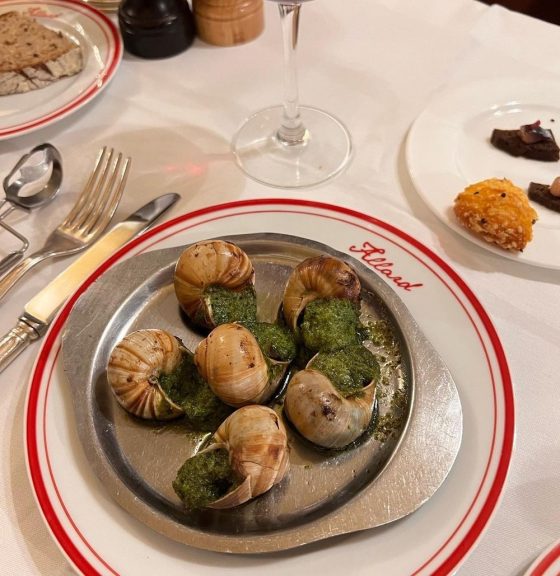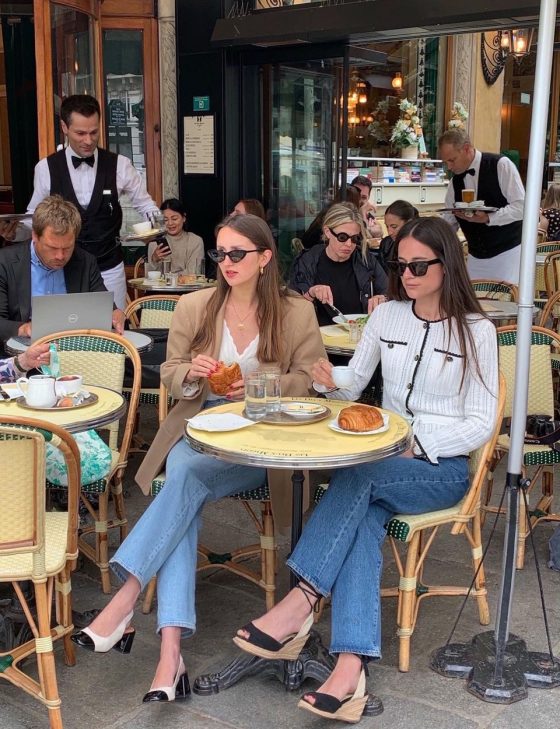As the City of Light shines brightly on the global stage, the eternal debate between French and American lifestyles has sparked a fascination that transcends borders. While the French are renowned for their effortless chic, sipping coffee at charming sidewalk cafes and effortlessly swooning over haute couture, their American counterparts are often associated with a more laid-back, fast-paced approach to life.
But what lies beneath the surface of these two seemingly disparate cultures? Is it the notion of joie de vivre versus the pursuit of happiness? The art of slow living versus the hustle and bustle of the 24/7 grind? As we explore the intricacies of French and American lifestyles, we’ll uncover the secrets that set these two nations apart, and perhaps, just perhaps, discover a little bit of ourselves in the process.

Culinary Traditions: French Gastronomy vs. American Fast Food Culture
Culinary traditions serve as a mirror to the values and lifestyle of a culture, and when comparing French gastronomy to American fast food culture, the differences are striking and reflective of deeper societal norms. French gastronomy is celebrated for its emphasis on quality, technique, and the artistry of cooking. Meals are often seen as an opportunity for social engagement, where time is devoted to savoring each course, incorporating fresh, local ingredients, and mastering traditional cooking methods. The French take great pride in their culinary heritage, viewing food as not merely sustenance but as a cultural expression that fosters community and pleasure. This culinary approach aligns with the French lifestyle, where leisure, family gatherings, and a slow-paced dining experience are valued.
In contrast, American fast food culture exemplifies a lifestyle that prioritizes convenience and speed, often reflecting the fast-paced nature of modern American life. Fast food restaurants prioritize quick service and affordability, catering to a society on the go where meals are often consumed in transit rather than at the dining table. While this approach can accommodate busy schedules and offer accessibility, it raises concerns about nutritional quality and the loss of a communal dining experience. The prevalence of fast food mirrors a broader American tendency toward instant gratification, encapsulating a lifestyle that values efficiency over tradition. Such culinary differences illustrate not only the contrasting approaches to food but also the underlying philosophies guiding each culture—where France cherishes the art and slow appreciation of food, the United States embraces speed and convenience. These culinary traditions ultimately reflect wider cultural values, influencing not just how people eat, but how they connect with one another and the world around them.
Fashion Sense: Chic Parisian Style vs. Casual American Attire
When contrasting the fashion sense of Chic Parisian style with casual American attire, a number of distinctions come to the fore that not only highlight differences in personal expression but also reflect broader cultural attitudes towards style and lifestyle. Parisian fashion is often characterized by its effortless elegance, where less is more. Staples such as tailored blazers, well-fitted jeans, and classic trench coats can be found in a typical Parisian’s wardrobe, often paired with scarves and chic yet comfortable footwear. The emphasis is on quality over quantity, with pieces being chosen for their timeless appeal and ability to convey poise and sophistication. This approach to dressing aligns with the broader French lifestyle that values intentionality and artistry in both life and style.
On the other hand, casual American attire tends to prioritize comfort and practicality, reflecting a more laid-back approach. Staples like t-shirts, hoodies, and sneakers dominate the wardrobe, embodying a culture that often values convenience and self-expression over formality. American casualwear embraces vibrant colors, graphic designs, and diverse influences ranging from streetwear to collegiate styles, illustrating a more eclectic fashion ethos.
While both styles have their own merits, the chic Parisian aesthetic offers a glimpse into a world where fashion serves as a statement of cultural pride, whereas American attire embraces an easy-going philosophy that celebrates individuality and comfort. Ultimately, these differences not only inform personal style but also shed light on the lifestyles embodied within each culture, showcasing how fashion is intrinsically linked to identity and social norms.
Work-Life Balance: The French Approach to Leisure vs. the American Work Ethic
Work-life balance is a cornerstone of the French lifestyle, distinctly contrasting with the American work ethic. In France, leisure is not merely an added benefit but an essential component of daily life. The French typically prioritize time off, valuing extended vacations and regular breaks throughout the day, with many employees enjoying up to five weeks of paid vacation annually. This cultural commitment to leisure reflects a broader belief that personal well-being and downtime are vital for productivity and creativity.
In stark contrast, the American work ethic often emphasizes long hours and constant availability, with many professionals willing to sacrifice personal time for career advancement. The relentless drive for success in the U.S. can lead to burnout, as workers feel pressured to stay connected and work late, often at the expense of their personal lives. This fundamental difference not only shapes workplace dynamics but also influences social interactions and family life, with the French embracing a slower-paced lifestyle that allows for deep connections, while Americans may find themselves navigating a more fast-paced, achievement-oriented existence.
The French view of work and leisure fosters a holistic approach to living, underscoring the importance of striking a balance that allows people to recharge and enjoy life’s pleasures, leading to a higher quality of life.
Socializing: The Importance of Dining and Gatherings in France vs. Casual Meet-ups in the U.S.
Socializing plays a pivotal role in the cultural fabric of both France and the United States, yet the nuances of how these social interactions manifest reveal deeper insights into each society’s lifestyle. In France, dining and gatherings are steeped in tradition and are seen as fundamental to community and familial bonds. The act of sharing a meal is often a multi-hour affair, where not just food, but conversation, philosophy, and relationships are nurtured. French dining emphasizes the importance of quality time, often seen as an art form that allows for the appreciation of gourmet cuisine and fine wines, complemented by engaging dialogues that flow as freely as the beverages. The French view these gatherings not merely as social events, but as essential rituals that strengthen community ties and reflect their reverence for life’s pleasures.
In contrast, socializing in the U.S. typically leans towards more casual meet-ups, often driven by convenience and time efficiency. Gatherings can take place in a variety of settings, from informal barbecues to quick coffee dates, emphasizing a more spontaneous and less structured environment. While camaraderie and friendship are equally valued in American culture, the pace of life often dictates that social interactions may feel hurried, with less emphasis on prolonged engagement. American meet-ups frequently revolve around shared activities or events, such as watching sports or attending concerts, reflecting a cultural inclination towards entertainment and leisure rather than culinary ceremony.
This stark difference highlights not just varied social practices, but also the broader lifestyle ideologies at play: the French savor the richness of the moment, while Americans often prioritize speed and efficiency in their social encounters.
Education Systems: The French École System vs. American Public Schooling
The education systems in France and the United States reflect broader cultural values and societal structures, showcasing the differences in lifestyle between the two nations. The French education system, known as the École system, is characterized by a centralized structure that emphasizes a rigorous curriculum and a national standard for all students. From an early age, French children are introduced to a formal education that prioritizes academic achievement, including a strong focus on subjects like mathematics, literature, and philosophy. This commitment to a standardized educational framework aims to foster equality and is heavily influenced by the French belief in the importance of critical thinking and intellectual development. In contrast, American public schooling operates on a more decentralized approach, with education governed at the state and local levels. This results in significant variations in curriculum, quality, and teaching methods across different regions.
While public schools in the U.S. emphasize creativity, individualism, and self-expression, they often lack the rigorous academic focus seen in French education. American students have the opportunity to explore a wider range of subjects, including arts and technology, reflecting the diverse cultural landscape of the nation. However, this system can also lead to discrepancies in educational quality, often linked to socioeconomic factors. Both systems reflect their countries’ values: France’s commitment to equality and academic discipline contrasts with America’s emphasis on diversity and personal development.
The École system produces a highly educated populace, while American public schools often encourage innovative thinking and adaptability. Consequently, the educational experiences in both nations cultivate distinct life skills that shape their respective societies.
Understanding these differences not only highlights the contrasts in education but also sheds light on the larger lifestyle distinctions between France and America, rooted in their historical and cultural contexts.
Public Transport: The French Reliance on Trains vs. American Car Culture
Public transport plays a critical role in shaping the lifestyles of both the French and Americans, highlighting a stark contrast in their cultural relationship with mobility. In France, the train system is not merely a means of transportation but a testament to the country’s commitment to public transit. The extensive network of high-speed trains (TGV) and regional services connects cities and rural areas alike, enabling people to traverse the country with ease. This reliance on trains fosters a sense of community and encourages social interactions, as well as an awareness of environmental concerns, given the relatively lower carbon footprint of rail travel compared to automobiles. The convenience and efficiency of the French rail system stand in sharp contrast to America’s car culture, where owning and driving a vehicle are often seen as synonymous with freedom and independence.
In the United States, sprawling cities and limited public transit options necessitate the use of cars for daily commuting, shopping, and leisure activities. This reliance on automobiles not only shapes individual lifestyles but also has broader implications on urban planning, leading to the development of car-centric infrastructures and suburban sprawls.
Consequently, while the French embrace the communal and efficient nature of train travel, Americans often navigate their lives through the lens of car ownership, emphasizing personal space and mobility. This divergence reflects deeper cultural values—collectivism versus individualism—and sets the tone for how each society approaches issues related to transportation, environmental sustainability, and social interaction.
Attitudes Toward Health and Wellness: The French Perspective vs. American Trends
When examining attitudes toward health and wellness, the French perspective often contrasts sharply with American trends, reflecting broader cultural values and societal norms. In France, a holistic view of health is prevalent, where wellness is intricately woven into the daily lifestyle rather than viewed as a series of separate activities. French individuals tend to prioritize moderation and balance in their diet, favoring fresh, seasonal ingredients and taking time to savor meals. This mindful approach extends beyond eating to encompass physical activity, which is often integrated into everyday life through walking and biking, rather than strictly regimented exercise routines. The French emphasis on pleasure, especially when it comes to food and social interactions, fosters a healthier relationship with eating, one that avoids the extremes of dieting prevalent in American culture.
Conversely, in the United States, the pursuit of health and wellness is frequently characterized by a more individualistic and performance-driven mindset. This can manifest in an array of intense workout regimes, subscription-based fitness programs, and a plethora of diet trends that often promote quick results at the expense of long-term sustainability. The American focus tends to lean towards the measurable aspects of health, such as weight loss and fitness milestones, rather than a more integrated sense of well-being. Consequently, this can lead to a cycle of yo-yo dieting and exercise burn-out, highlighting a disconnect from the intrinsic joy of physical activity and healthy eating. Moreover, the commercialization of wellness in the U.S. compounds this issue, with a market inundated with products promising idealized health outcomes rather than encouraging a comprehensive and enjoyable lifestyle approach.
Ultimately, these contrasting attitudes illustrate not only different health behaviors but also the varying societal values that shape individual choices within each culture.





